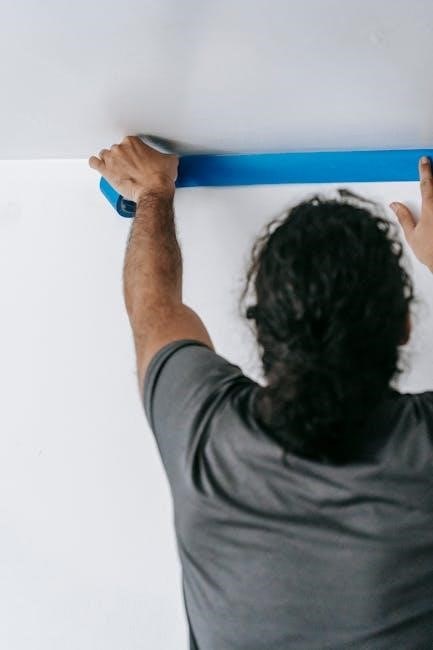Understanding boot width is crucial for comfort and fit. This guide explores men’s boot widths, from narrow to extra-wide, helping you choose the perfect fit for your needs.
1.1 Importance of Boot Width in Comfort and Fit
Boot width plays a critical role in ensuring comfort and proper fit. Ill-fitting boots can lead to discomfort, blisters, or even long-term foot health issues. While shoe size is often prioritized, width is equally important, as it directly affects how the boot hugs the foot. Narrow boots can cause pressure points, while overly wide boots may lack support. For men with wider feet, selecting the correct width is essential to avoid constriction and promote circulation. Ignoring boot width can compromise both performance and comfort, making it a key factor to consider for optimal footwear satisfaction.
1.2 Brief Overview of Boot Width Sizes
Men’s boot widths range from narrow to extra-wide, ensuring a tailored fit for various foot shapes. Common widths include B (narrow), D (standard), E (wide), EE (extra-wide), and EEE (extra-extra-wide). Each width corresponds to specific measurements, with differences of about 3/16 of an inch between sizes. For example, a B width measures 3.6–3.8 inches, while an EEE width is 4.4–4.6 inches. Understanding these sizes helps in selecting boots that provide optimal comfort and support, preventing issues like tightness or excessive movement. Accurate sizing ensures better performance and longevity of the boots.
Understanding Boot Widths
Boot widths are categorized to fit various foot shapes, ensuring comfort and proper support. Common sizes include B, D, E, EE, and EEE, with incremental differences of 3/16 inch.
2.1 Common Boot Widths for Men (B, D, E, EE, EEE)
Men’s boot widths are categorized as B (narrow), D (standard), E (wide), EE (extra wide), and EEE (extra extra wide). Each width increases by 3/16 of an inch, ensuring a precise fit. B is the narrowest, while EEE offers the widest comfort. D is the most common, fitting average foot widths. Understanding these sizes helps in selecting boots that align with your foot shape, preventing discomfort or restricted movement. Proper width ensures optimal support and comfort, making it essential to choose the right size for your needs.
2.2 Differences Between Men’s and Women’s Boot Widths
Men’s and women’s boot widths differ significantly due to foot shape and size. Men’s boots typically range from B (narrow) to EEE (extra extra wide), while women’s widths often include B, C, D, and sometimes E. Men’s widths are generally wider, with D being the standard for men and B for women. The measurements also vary slightly, as men’s feet are usually larger and wider. Understanding these differences is key to selecting the right fit, as assuming unisex sizing can lead to discomfort or poor fit. Proper width ensures optimal comfort and support for both genders.
2.3 How Boot Width Relates to Shoe Size
Boot width and shoe size are related but distinct measurements. While shoe size primarily indicates length, boot width focuses on the foot’s circumference. Men’s boot widths range from B (narrow) to EEE (extra extra wide), with D being the standard. Boot sizes often run smaller than shoe sizes, so a size 10 shoe might correspond to a size 9 boot. Understanding this relationship helps in selecting the correct fit, as boot width ensures comfort and support, while shoe size focuses on length. Proper alignment of both ensures optimal fit and performance for various activities.
Measuring Your Foot for the Perfect Boot Width
Accurate foot measurement ensures the best boot fit. Use a ruler or printable guide to measure width at the widest point, typically in the afternoon when feet are largest.
3.1 How to Accurately Measure Foot Width at Home
To measure foot width at home, place your foot on a flat surface with weight evenly distributed. Trace the outline of your foot on paper, ensuring the pencil is held perpendicular. Measure the widest part of the foot, typically across the ball, using a ruler. For accuracy, measure both feet and take the larger measurement. Use this to compare with boot width charts. For best results, measure in the afternoon, as feet tend to swell slightly during the day. This method ensures a precise fit for your boot width needs.
3.2 Understanding the Relationship Between Foot Shape and Boot Width
Foot shape significantly influences boot width selection. Narrow feet require slimmer widths like B, while wider feet need E, EE, or EEE. The ball and toe areas determine width needs. A square toe may require a wider boot for comfort. High arches or flat feet can also affect fit. Measuring foot width accurately helps match it to the correct boot size. Understanding your foot shape ensures proper alignment with boot width options, enhancing comfort and performance. This relationship is key to avoiding tightness or looseness, ensuring optimal fit for various activities and shoe styles.

Factors Influencing Boot Width Choice
Foot shape, activity type, and brand sizing impact boot width selection. Proper fit ensures comfort and performance, making these factors crucial for the right choice.
4.1 Foot Shape and Its Impact on Boot Fit
Foot shape significantly influences boot fit, as different shapes require varying widths. For instance, wider feet may need EE or EEE widths, while narrower feet prefer B or D. The alignment of toes and the overall structure of the foot also play a role. If the boot is too tight, it can cause discomfort and restrict movement. Conversely, a boot that’s too loose may lead to blisters or poor support. Understanding your foot’s specific shape helps in selecting the most comfortable and supportive boot width, ensuring optimal performance and long-lasting wear.
4.2 Activity Type and Boot Width Requirements
Activity type greatly influences boot width needs. Hiking or outdoor activities often require wider boots for stability and comfort over uneven terrain. Narrower boots may restrict movement and cause discomfort during long treks. Conversely, work boots might need a snug fit to prevent slipping in hazardous environments. The width should align with the activity’s demands, ensuring both support and flexibility. Proper boot width enhances performance and reduces the risk of fatigue or injury, making it essential to consider your primary use when selecting the ideal boot width.
4.3 Brand Differences in Boot Width Sizing
Boot width sizing can vary significantly between brands, even for the same labeled width. Some brands offer narrower fits, while others cater to wider feet. For instance, Double-H Boots has its own size chart, highlighting the diversity in measurements. This inconsistency means that a size D in one brand might not match another. It’s essential to consult each brand’s specific sizing guide to ensure the best fit. Understanding these differences helps in making informed decisions, as boot width directly impacts comfort and performance, especially for activities like hiking or work.

How to Choose the Right Boot Width
Choosing the right boot width involves trying boots in the afternoon, walking around to test fit, and considering sock thickness for a comfortable, proper fit.
5.1 Trying Boots Before Purchasing
Trying boots before purchasing is essential for ensuring the right fit. Visit stores in the afternoon, as feet tend to swell throughout the day. Wear the same type of socks you plan to use with the boots to gauge comfort and support. Pay attention to how the boots feel while standing and walking. If possible, walk around the store to test the fit under movement. This step helps avoid the hassle of returns and ensures the boots provide the necessary comfort and performance for their intended use.
5.2 The Role of Socks in Boot Fit
Socks play a significant role in achieving the perfect boot fit. The thickness and material of socks can affect how snug or loose the boots feel. Thicker socks, often used for hiking or cold weather, may require a slightly wider boot to accommodate the added bulk. Conversely, thinner socks might call for a narrower fit. Moisture-wicking fabrics are ideal for active use, as they keep feet dry and comfortable. Always try boots with the type of socks you plan to wear to ensure proper fit and performance for your specific needs and activities.
5.3 How to Determine if a Boot is Too Tight or Too Loose
To ensure the best fit, check for key indicators. A boot that’s too tight may cause pressure on your toes or restrict movement, while a loose boot can lead to slipping. Pay attention to how your foot feels—there should be enough room to wiggle your toes comfortably without excessive space. Walk around to test stability; if your foot slides excessively or feels cramped, the fit isn’t right. Proper fit balances comfort and support, ensuring optimal performance for your activity. Always prioritize how the boot feels during movement to make the right choice.
Men’s Boot Width Size Chart
Standard boot widths for men include B (3.6-3.8″), D (4.0-4.2″), E (4.2-4.4″), EE (4.4-4.6″), and EEE (4.6-4.8″). These measurements ensure proper fit and comfort.
- B (Narrow): 3.6–3.8 inches
- D (Standard): 4.0–4.2 inches
- E (Wide): 4.2–4.4 inches
- EE (Extra Wide): 4.4–4.6 inches
- EEE (Extra Extra Wide): 4.6–4.8 inches
6.1 Standard Boot Width Measurements in Inches
Men’s boot widths are standardized to ensure a consistent fit. The measurements are as follows: B (Narrow): 3.6–3.8 inches, D (Standard): 4.0–4.2 inches, E (Wide): 4.2–4.4 inches, EE (Extra Wide): 4.4–4.6 inches, and EEE (Extra Extra Wide): 4.6–4.8 inches. These increments provide a gradual increase in width, typically by 3/16 of an inch between sizes. Understanding these measurements helps in selecting the right boot width for optimal comfort and support. Accurate measurements ensure a proper fit, preventing discomfort or restricted movement during wear.
6.2 Comparing Boot Widths Across Different Brands
Boot widths can vary slightly between brands, even within the same size designation. For example, a D width in one brand might be slightly narrower or wider than another. This variation occurs due to differences in lasts (the molds used to shape boots) and materials. Some brands offer detailed size charts to help compare widths accurately. It’s essential to consult each brand’s specific measurements, as standard widths like B, D, E, EE, and EEE may not be uniform across manufacturers. This ensures the best fit and comfort, especially for those with specific width requirements.

Common Mistakes When Selecting Boot Width

Common mistakes include assuming boot size equals shoe size and ignoring width’s role in fit. These oversights can lead to discomfort and poor performance.
7.1 Assuming Boot Size Equals Shoe Size
One common mistake is assuming boot size directly matches shoe size. However, boot sizing can differ due to variations in construction and materials. While boot size tends to be one size smaller than shoe size, this isn’t universal. Ignoring width and focusing solely on length can lead to poor fit and discomfort. Always consider both size and width for optimal comfort and performance, as boots often have unique fits compared to regular shoes.
7.2 Ignoring the Importance of Width in Boot Fit
Overlooking boot width can lead to discomfort and poor performance. Boot widths vary from B (narrow) to EEE (extra-extra-wide), differing by 3/16 of an inch. Neglecting width often results in tight boots causing blisters or overly loose boots that lack support. Proper width ensures optimal comfort and mobility, especially for activities like hiking. Always measure foot width accurately and consider foot shape when selecting boots. Ignoring width can compromise both fit and functionality, making it essential to prioritize width alongside size for the best boot fit.
Tips for Ensuring the Best Boot Fit
Try boots in the afternoon, as feet swell during the day. Walk around the store to test fit and comfort, ensuring a snug yet non-restrictive feel.
8.1 Trying Boots in the Afternoon
Trying boots in the afternoon ensures the best fit, as feet naturally swell throughout the day. This practice helps avoid purchasing boots that are too tight. By testing boots when your feet are at their largest, you can ensure a comfortable fit. Additionally, wear the same type of socks you plan to use with the boots for an accurate fit. This simple tip can make a significant difference in long-term comfort and performance, ensuring your boots are neither too restrictive nor too loose.
8.2 Walking Around the Store to Test Fit
Walking around the store is essential to test the fit of boots. This simple act reveals how the boots perform during movement. Pay attention to comfort, support, and any signs of tightness or slipping. By mimicking real-world activities, you can assess the boots’ suitability for their intended use. Whether for work, hiking, or casual wear, walking ensures the boots meet your needs. This practical step helps confirm that the chosen width and size provide optimal comfort and performance, making it a crucial part of the selection process.

Boot Width Options for Men with Wide Feet
Men with wide feet benefit from E, EE, or EEE widths. Brands like EEE offer extra room, while square-toe styles enhance comfort. Try boots on and consider cushioning for optimal fit.
9.1 Best Boot Brands for Wide Feet
For men with wide feet, brands like Thorogood, Merrell, and Keen offer excellent options. Thorogood’s EEE widths provide ample space, while Merrell’s wide sizes ensure comfort. Keen’s roomy toe boxes cater to wider feet, offering both durability and support. These brands prioritize comfort and fit, making them ideal for those seeking extra width. Their designs often feature cushioned insoles and sturdy outsoles, ensuring long-lasting wear. Whether for work or outdoor activities, these brands deliver reliable choices for men needing wider boot options.
9.2 How to Stretch or Break In Boots for Wider Feet

Breaking in boots for wider feet can be done using several methods. Start by wearing thick socks and walking around the house to mold the boots to your feet. Use a shoe stretcher to target specific areas like the toe box or heel. Applying heat with a hair dryer can soften the material, making it more pliable. For leather boots, condition them regularly to maintain flexibility. Gradual wear is key—begin with short periods and increase as the boots conform to your feet. Patience ensures comfort and prevents discomfort or blisters during the break-in process.

The Relationship Between Boot Width and Comfort
Proper boot width ensures long-term comfort, preventing blisters and cramped toes. Incorrect widths can cause discomfort and stress, making it essential to choose the right fit for optimal support.
10.1 How Boot Width Affects Long-Term Comfort
Boot width plays a significant role in long-term comfort by ensuring proper fit and preventing discomfort. Ill-fitting boots, whether too tight or too loose, can lead to blisters, cramped toes, and foot fatigue. Over time, inadequate boot width can cause chronic issues like bunions or calluses. Properly fitted boots provide adequate space for toes to move naturally, reducing friction and stress on the feet. This promotes better blood circulation and overall foot health. Choosing the correct width ensures sustained comfort during extended wear, making it essential for both everyday use and high-activity environments. Insoles can further enhance comfort if needed.
10.2 The Role of Insoles in Enhancing Comfort
Insoles play a crucial role in enhancing boot comfort by providing additional cushioning, arch support, and moisture-wicking properties. They can compensate for boot width limitations, offering a customized fit. High-quality insoles redistribute pressure, reducing hotspots and discomfort during extended wear. For men with wider feet, insoles can help maximize space within the boot. While insoles are not a substitute for proper boot width, they significantly improve long-term comfort and performance. They are especially beneficial for individuals with specific foot needs, ensuring a more enjoyable and supportive boot-wearing experience.

Boot Width and Performance
Boot width significantly impacts performance, ensuring proper support and mobility. The right fit enhances stability and comfort, crucial for activities like hiking, work, or sports.
11.1 How Boot Width Impacts Hiking and Outdoor Activities
Boot width plays a critical role in hiking and outdoor performance. Proper fit ensures comfort, preventing blisters and restricted movement. Narrow widths may cause discomfort, while excessive width can lead to friction. For rugged terrains, a snug yet roomy fit is essential for stability and control. Wider boots accommodate thicker socks, crucial for cold conditions, while standard widths balance support and flexibility. Ill-fitting boots can hinder mobility, affecting overall performance. Choosing the right width enhances endurance, ensuring optimal comfort and efficiency during long hikes or demanding outdoor activities.
11.2 Boot Width Considerations for Work Boots
Boot width is vital for work boots, as it directly impacts comfort and performance. Narrow widths may restrict toe movement, while excessive width can compromise support. For jobs requiring long hours of standing, a standard or wide width is often ideal, providing adequate toe room. Construction or heavy-duty work may benefit from wider boots for stability, while lighter tasks might prefer a snug fit. Proper width ensures reduced fatigue and prevents blisters. Additionally, work boots with safety features like steel toes may require specific widths for optimal protection and comfort, making accurate sizing essential for workplace safety and efficiency.

The Future of Boot Width Sizing
Advances in 3D scanning and custom fitting technology promise precise boot width measurements, enhancing comfort and performance for all foot shapes and activities.
12.1 Advances in Custom Boot Fitting Technology
Custom boot fitting technology is revolutionizing the industry with 3D scanning and AI-driven measurements. Brands like Thorogood and Carhartt are adopting these tools to create precise, personalized fits. This innovation allows for boots tailored to individual foot shapes, enhancing comfort and performance. Advanced materials and manufacturing processes enable mass customization, ensuring durability without compromising on fit. As technology evolves, expect even more accurate and accessible solutions, making perfect-fit boots a reality for everyone. This shift is transforming how men shop for boots, prioritizing comfort and functionality like never before.
12.2 The Rise of 3D Scanning for Perfect Boot Fit
3D scanning is transforming boot fitting by providing precise measurements of foot shape, arch type, and toe alignment. This technology creates a digital map of the foot, ensuring boots match individual contours. Brands like Thorogood and Carhartt are integrating 3D scanners in stores, allowing customers to find their ideal fit quickly. The process eliminates guesswork, reduces returns, and enhances comfort. As 3D scanning becomes more accessible, it’s expected to revolutionize the boot industry, offering unparalleled accuracy and convenience for shoppers. This innovation is paving the way for a future where perfect-fit boots are the norm, not the exception.
Glossary of Boot Width Terms
Key terms include boot width (B, D, E, EE, EEE), foot shape, and size chart. These terms help determine the perfect fit for men’s boots, ensuring comfort and support.
13.1 Key Terms to Know When Shopping for Boots
Key terms include boot width (B, D, E, EE, EEE), boot size (often 1 size smaller than shoe size), and foot shape (affects fit). Understanding these terms helps shoppers identify their ideal boot fit, ensuring comfort and support. Boot width refers to the measurement across the ball of the foot, while boot size indicates length. Foot shape varies, impacting how different widths fit. These terms are essential for navigating size charts and selecting the right boots for your needs.
Conclusion
Selecting the right boot width is essential for comfort, performance, and long-term satisfaction. This guide has provided insights into men’s boot widths, measurement techniques, and factors influencing fit. By understanding terms like boot width, foot shape, and brand differences, you can make informed decisions. Remember, proper fit enhances comfort and support, especially for activities like hiking or work. Use this guide to find your ideal boot width and enjoy a perfect fit. With evolving technology, the future of boot fitting promises even greater customization and accuracy for all foot types.
